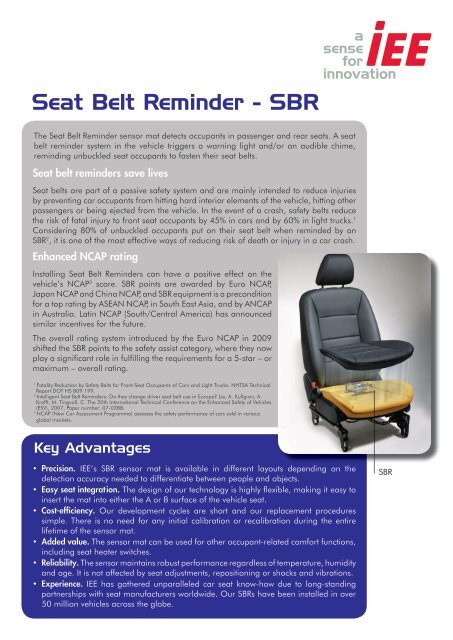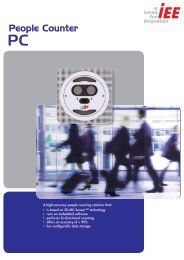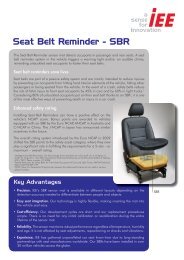Seat Belt Reminder SBR - IEE
Seat Belt Reminder SBR - IEE
Seat Belt Reminder SBR - IEE
Create successful ePaper yourself
Turn your PDF publications into a flip-book with our unique Google optimized e-Paper software.
<strong>Seat</strong> <strong>Belt</strong> <strong>Reminder</strong> - <strong>SBR</strong><br />
The <strong>Seat</strong> <strong>Belt</strong> <strong>Reminder</strong> sensor mat detects occupants in passenger and rear seats. A seat<br />
belt reminder system in the vehicle triggers a warning light and/or an audible chime,<br />
reminding unbuckled seat occupants to fasten their seat belts.<br />
<strong>Seat</strong> belt reminders save lives<br />
<strong>Seat</strong> belts are part of a passive safety system and are mainly intended to reduce injuries<br />
by preventing car occupants from hitting hard interior elements of the vehicle, hitting other<br />
passengers or being ejected from the vehicle. In the event of a crash, safety belts reduce<br />
the risk of fatal injury to front seat occupants by 45% in cars and by 60% in light trucks. 1<br />
Considering 80% of unbuckled occupants put on their seat belt when reminded by an<br />
<strong>SBR</strong> 2 , it is one of the most effective ways of reducing risk of death or injury in a car crash.<br />
Enhanced NCAP rating<br />
Installing <strong>Seat</strong> <strong>Belt</strong> <strong>Reminder</strong>s can have a positive effect on the<br />
vehicle’s NCAP 3 score. <strong>SBR</strong> points are awarded by Euro NCAP,<br />
Japan NCAP and China NCAP, and <strong>SBR</strong> equipment is a precondition<br />
for a top rating by ASEAN NCAP, in South East Asia, and by ANCAP<br />
in Australia. Latin NCAP (South/Central America) has announced<br />
similar incentives for the future.<br />
The overall rating system introduced by the Euro NCAP in 2009<br />
shifted the <strong>SBR</strong> points to the safety assist category, where they now<br />
play a significant role in fulfilling the requirements for a 5-star – or<br />
maximum – overall rating.<br />
1 Fatality Reduction by Safety <strong>Belt</strong>s for Front-<strong>Seat</strong> Occupants of Cars and Light Trucks. NHTSA Technical<br />
Report DOT HS 809 199.<br />
2 Intelligent <strong>Seat</strong> <strong>Belt</strong> <strong>Reminder</strong>s: Do they change driver seat belt use in Europe? Lie, A. Kullgren, A.<br />
Krafft, M. Tingvall, C. The 20th International Technical Conference on the Enhanced Safety of Vehicles<br />
(ESV), 2007, Paper number: 07-0388.<br />
3 NCAP (New Car Assessment Programme) assesses the safety performance of cars sold in various<br />
global markets.<br />
Key Advantages<br />
• Precision. <strong>IEE</strong>’s <strong>SBR</strong> sensor mat is available in different layouts depending on the<br />
detection accuracy needed to differentiate between people and objects.<br />
• Easy seat integration. The design of our technology is highly flexible, making it easy to<br />
insert the mat into either the A or B surface of the vehicle seat.<br />
• Cost-efficiency. Our development cycles are short and our replacement procedures<br />
simple. There is no need for any initial calibration or recalibration during the entire<br />
lifetime of the sensor mat.<br />
• Added value. The sensor mat can be used for other occupant-related comfort functions,<br />
including seat heater switches.<br />
• Reliability. The sensor maintains robust performance regardless of temperature, humidity<br />
and age. It is not affected by seat adjustments, repositioning or shocks and vibrations.<br />
• Experience. <strong>IEE</strong> has gathered unparalleled car seat know-how due to long-standing<br />
partnerships with seat manufacturers worldwide. Our <strong>SBR</strong>s have been installed in over<br />
50 million vehicles across the globe.<br />
<strong>SBR</strong>
Reliable Technology<br />
About Us<br />
The <strong>IEE</strong> <strong>Seat</strong> <strong>Belt</strong> <strong>Reminder</strong> consists of a sensor mat inserted in the vehicle<br />
seat and is based on a technology which uses variable resistance to measure<br />
pressure applied to sensor cells.<br />
The mat itself is composed of two sandwiched carrier sheets held together<br />
by an adhesive. Increased pressure on the sensor mat causes an electrical<br />
resistance change, which tells the system that the seat is occupied. The seat<br />
belt reminder system is automatically activated and visually and/or audibly<br />
reminds the occupant to buckle up.<br />
The key advantage of using force sensing cells is their extreme efficiency.<br />
The technology is also designed for thin applications, which is crucial for a<br />
sensor mat that needs to be flexible in order to be inserted into the vehicle<br />
seat.<br />
<strong>IEE</strong> is an innovative developer of specialized sensing systems. Our sensing technologies<br />
are dedicated to the following markets: Transportation & Automotive, Public & Commercial<br />
Infrastructure, Consumer and Medical & Healthcare.<br />
<strong>IEE</strong> was founded in 1989 and is headquartered in Luxembourg. We operate in Europe, the<br />
U.S. and Asia, and employ 1,600 people worldwide. More than 10% of our workforce is<br />
dedicated to Research and Development.<br />
For more information, please visit www.iee.lu.<br />
FS-<strong>SBR</strong>-2012-04-03

















